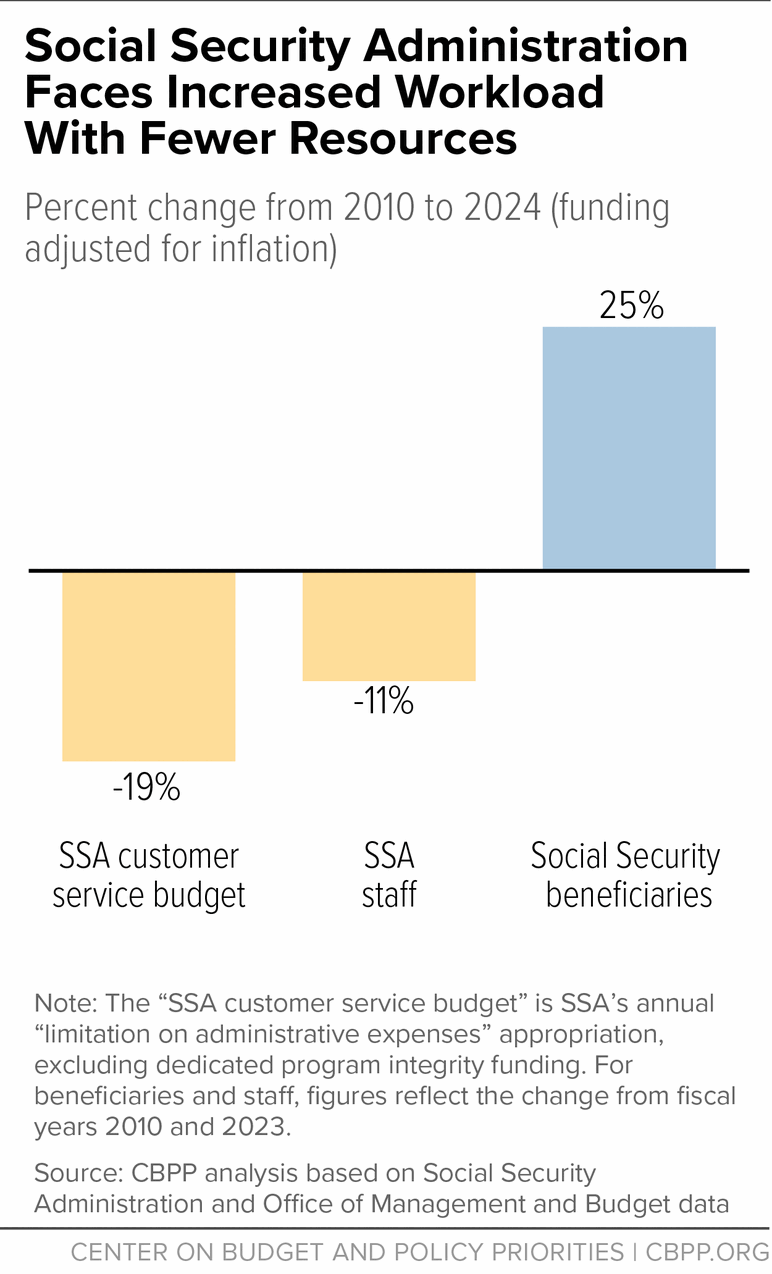BEYOND THE NUMBERS
SSA Budget Will Worsen Customer Service Crisis, But Investment in 2025 Could Fund Turnaround
The Social Security Administration (SSA) is experiencing a customer service crisis, with long hold times on the phone and record-long waits for disability determinations, fueled by over a decade of austere funding. Yet the agency’s 2024 appropriation falls short of the amount needed to address these problems. To give the nation’s retirees, survivors, and people with disabilities the service they deserve, SSA will need significantly more investment in 2025.
Adequate funding can make a real difference in an agency’s service to the public. That’s been demonstrated by the recent experience of the Internal Revenue Service (IRS): thanks to more money in the Inflation Reduction Act, the IRS sharply improved call center wait times, served more taxpayers in person, and created new online services.
Due to funding constraints, SSA has been forced to serve millions more people with fewer staff. Between 2010 and 2024, SSA’s customer service budget fell 19 percent, after inflation, with its staffing falling 11 percent. These cuts happened even as the number of Social Security beneficiaries grew by over 13 million, or 25 percent. (See chart.)
That math simply doesn’t add up to adequate customer service — and so applicants and beneficiaries pay the price. The wait for an initial disability determination is at a record high of nearly eight months, with an additional seven-month wait for those who appeal. The average hold time on the phone is nearly 40 minutes, and even longer at peak times. And processing times are slower, which means that when beneficiaries are overpaid, the amounts balloon — at times reaching tens of thousands of dollars.
Despite these struggles, SSA’s 2024 appropriation effectively freezes its customer service funding at 2023 levels, increasing it by only 0.2 percent ($23 million). By contrast, SSA’s fixed cost increases alone will cost about $600 million this year. While the funding provided will allow limited hiring in 2024, it’s only sufficient to replace staffing losses sustained during the hiring freeze triggered by the continuing resolution — not to rebuild over the long term.
The IRS example illustrates how additional funding for customer service can produce tangible results. Before last tax season’s improvements, a decade of steep budget cuts had left the IRS in a crisis similar to SSA’s — unable to provide the customer service that taxpayers deserved or to adequately enforce the nation’s tax laws. As many as 9 in 10 taxpayer phone calls to the IRS went unanswered.
But significant investment through the Inflation Reduction Act transformed the quality of the IRS’s customer service. Now, millions of taxpayers are benefiting from a better-funded IRS that is answering more taxpayer questions, processing returns more quickly, and issuing refunds to families around the country. Since the Inflation Reduction Act was passed, the IRS cut wait times on the phone to five minutes or less; served 235,000 more tax filers in person in fiscal year 2023 compared to 2022; and added online services such as secure messaging, live chat, and virtual assistants.
SSA could begin to restore its customer service, too, if policymakers boosted funding for the agency. President Biden has requested an increase of 9 percent (about $1.2 billion) in SSA’s customer service budget in 2025 compared to 2024. About half of the President’s request would cover fixed cost increases, such as salary, benefits, and rent increases.
The remainder would be used to begin to improve SSA service — an important first step in what must be a multi-year rebuilding effort. According to SSA, funding at the level included in the President’s 2025 budget would cut hold times in half, reducing them from 38 minutes to under 20. It would eliminate the hearings backlog. And it would allow agency staff to process nearly 300,000 disability decisions.
Policymakers should prioritize SSA funding in the upcoming appropriations cycle, even as they continue to face tight caps on overall non-defense discretionary funding in 2025, as they did in 2024. By investing in SSA in 2025, policymakers can help the agency begin to restore the customer service that beneficiaries deserve.

